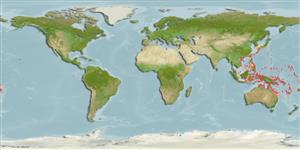>
Blenniiformes (Blennies) >
Tripterygiidae (Triplefin blennies) > Tripterygiinae
Etymology: Helcogramma: Greek, helkos, -eos, -ous = ulcer, sore + Greek, gramma = letter, mark (Ref. 45335).
More on author: Bleeker.
Environment: milieu / climate zone / depth range / distribution range
Ecologie
marien rifbewoner; diepte 0 - 6 m (Ref. 58018). Tropical
Western Pacific: East Andaman Sea (Thailand), Malaysia (Tioman Island), Indonesia (Belitung, Komodo, Halmahera, and Banda Sea), Philippines (Luzon), Papua New Guinea (wewak), Solomon Islands, Vanuatu, and Taiwan.
Grootte / Gewicht / Leeftijd
Maturity: Lm ? range ? - ? cm
Max length : 4.5 cm SL mannelijk / geslacht onbekend; (Ref. 559)
Korte beschrijving
Determinatiesleutels | Morfologie | Morfometrie
Dorsale stekels (totaal) : 16 - 18; Dorsale zachte stralen (totaal) : 8 - 11; Anale stekels: 1; Anale zachte stralen: 16 - 19. Trunk without longitudinal stripes; symphyseal dentary pores 3 or more; lateral line with fewer than 25 scales; anal fin with fewer than 19 rays; male with bluish white stripe from corner of jaw onto preopercle (Ref. 94457). Additional description: Dorsal fin III + XIII-XV + 8-11; anal fin I, 16-19; pectoral rays 16-17; pelvic fin I,2. Lateral line continuous, pored scales 21-29; head and narrow strip on upper back scaleless, nape with only a few scales. Mandibular sensory pores 3-8 + 3-9 + 3-8 (usually 3+3+3). Male greyish green, head ventrally black, cheek with blue horizontal stripe; body vertical bars H-shaped, brownish; zone between pectoral fin and operculum greenish grey. Female overall translucent, head marks brown, H-bars faint, fins translucent (Ref. 90102).
Adults inhabit coral and rocky bottoms at depths of 6 m and shallower (Ref. 90102). Eggs are hemispherical and covered with numerous sticky threads that anchor them in the algae on the nesting sites (Ref. 240). Larvae are planktonic which occur primarily in shallow, nearshore waters (Ref. 94114).
Levenscyclus en paargedrag
Maturiteit | Voortplanting | Paaien | Eieren | Fecunditeit | Larven
Masuda, H., K. Amaoka, C. Araga, T. Uyeno and T. Yoshino, 1984. The fishes of the Japanese Archipelago. Vol. 1. Tokai University Press, Tokyo, Japan. 437 p. (text). (Ref. 559)
Status op de Rode Lijst van het IUCN (Ref. 130435: Version 2024-2)
Gevaar voor de mens
Harmless
Gebruik door de mens
Tools
Speciale rapporten
Download XML
Internetbronnen
Estimates based on models
Preferred temperature (Ref.
123201): 24.7 - 29.3, mean 28.6 °C (based on 1714 cells).
Fylogenetische diversiteitsindex (Ref.
82804): PD
50 = 0.5000 [Uniqueness, from 0.5 = low to 2.0 = high].
Bayesian length-weight: a=0.00955 (0.00304 - 0.03005), b=3.02 (2.77 - 3.27), in cm total length, based on LWR estimates for this (Sub)family-body shape (Ref.
93245).
Trofisch niveau (Ref.
69278): 3.1 ±0.3 se; based on size and trophs of closest relatives
Weerstandsvermogen (Ref.
120179): Hoog, minimale populatieverdubbelingstijd minder dan 15 maanden (Preliminary K or Fecundity.).
Fishing Vulnerability (Ref.
59153): Low vulnerability (10 of 100).
